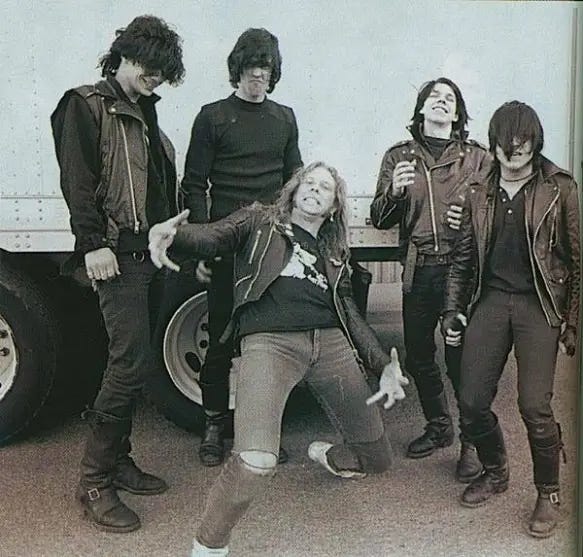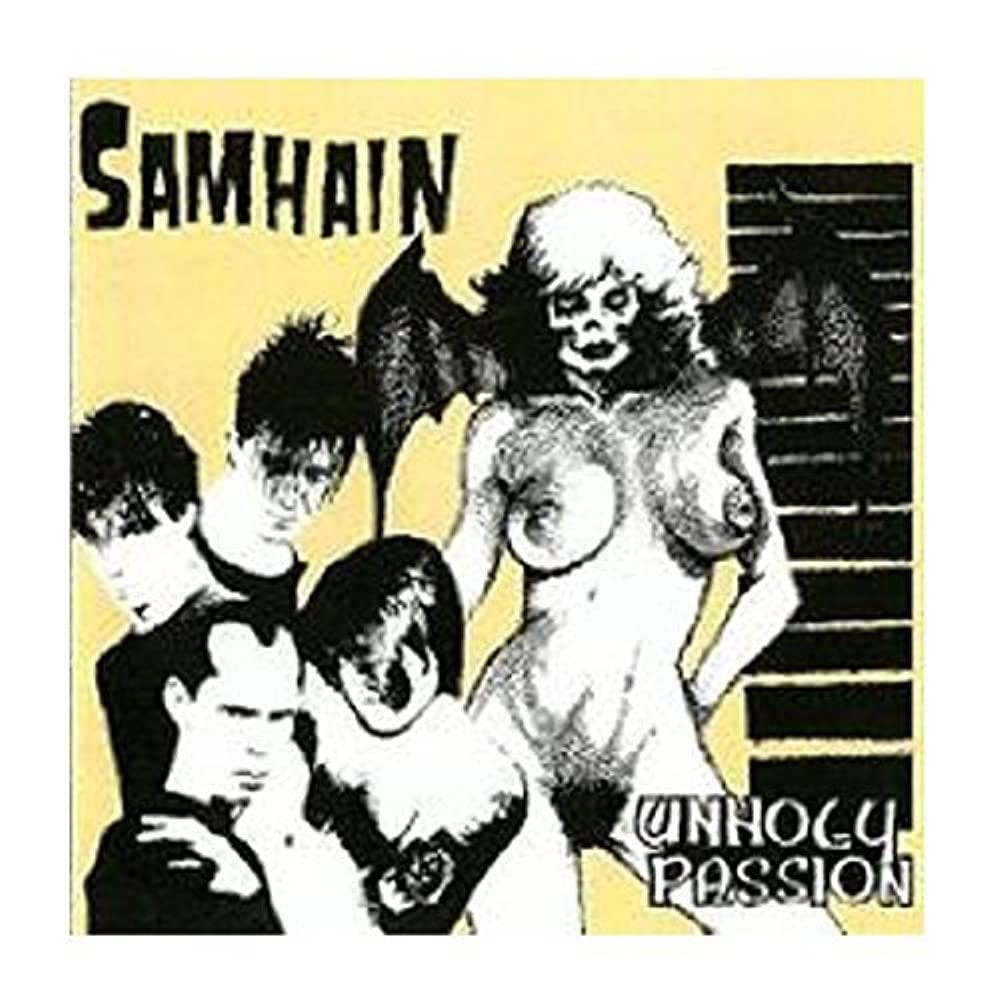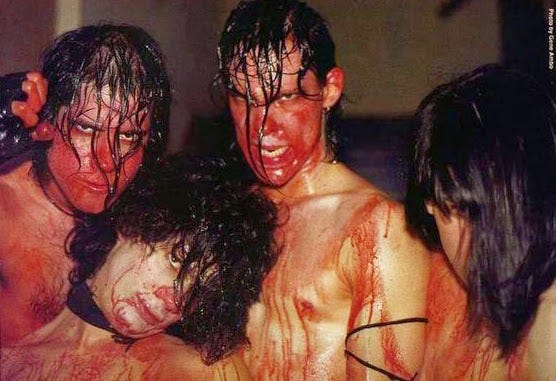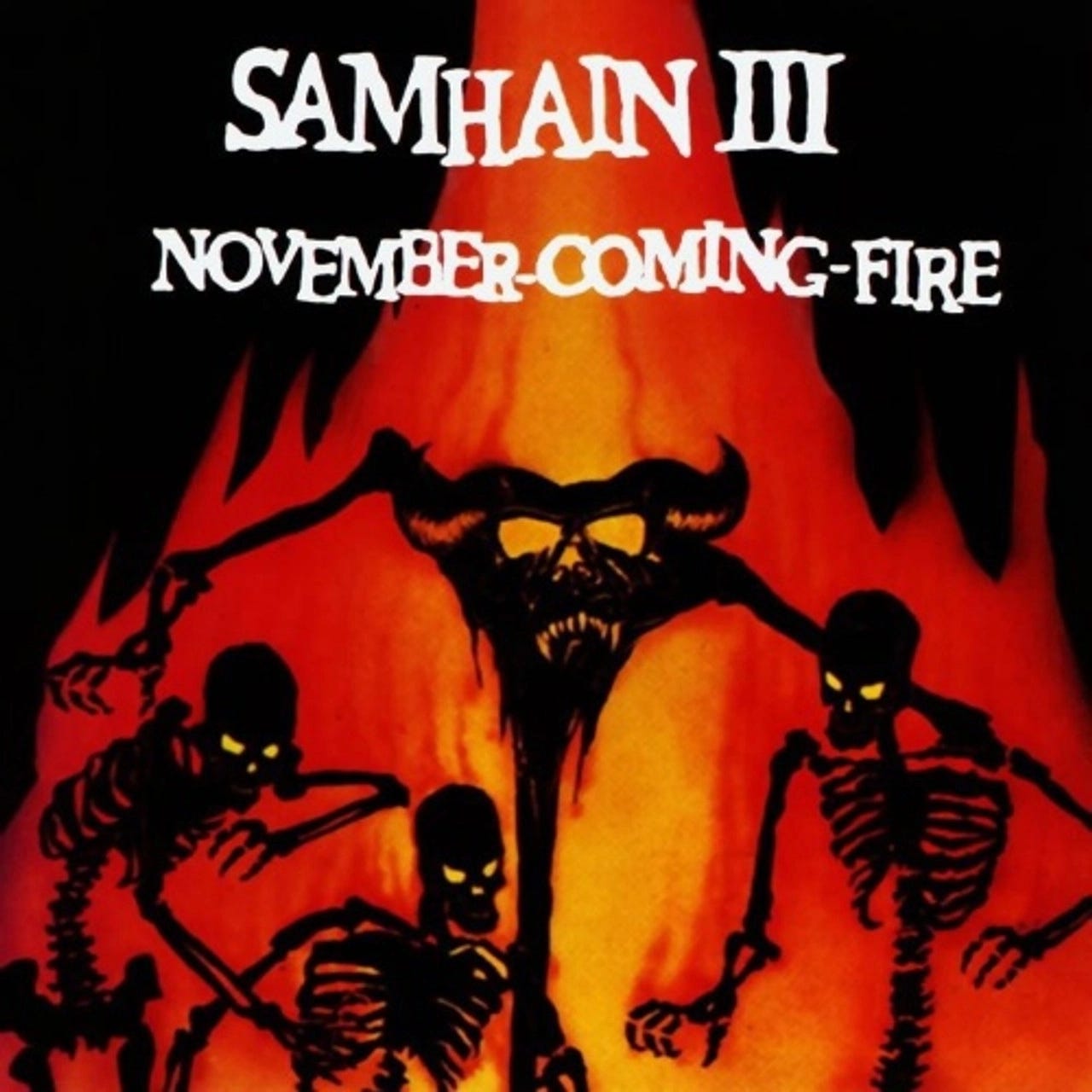
There is a human slaughterhouse
Up on the hill, the road is red
And those who ignore
And those who pretend
It does not exist
End up in its hall
My blood goes to work
I hear the howl
— “The Howl” (1984)
Even before The Misfits called it a day in 1983, Glenn Danzig was busy writing songs for his next project. In an interview with Loudersound, Danzig said that he envisioned the new band as more dynamic and sonically capable of going beyond horror punk:
“It was difficult for me to work with these guys [The Misfits] because they weren’t prepared to put in the hours practicing. I wanted to move things forward and they didn’t seem to have the same outlook. So it was time for me to move on. I know what I wanted, and that was to bring in people who cared about their musicianship and would improve as we went along. I did think about calling this band Danzig, but I just felt it was a little too egotistical.”
This new band, Samhain, was initially supposed to be a supergroup featuring some of the biggest names in hardcore punk. Alongside Danzig would be Al Pike from Reagan Youth, Brian Baker and Lyle Preslar from Minor Threat, and Graham McCulloch from Negative Approach. Every one of these musicians would contribute to tracks on Initium, the first Samhain album. However, by the time of the album’s release, Danzig had given up on the supergroup concept. By 1984, Samhain included Danzig, former Misfits photographer Eerie Von on bass, and drummer Steve Zing from the band Mourning Noise.
Initium is noticeably much darker and dirtier than anything The Misfits ever produced. Even the Samhain version of “Horror Business” (simply called “Horror Biz”) is heavier than the original. All that said, Initium still contains more than a few traces of what made The Misfits so great. The songwriting is mostly straightforward horror punk, albeit with a metal edge. Lyrically, the songs on Initium are somewhere between Misfits-like and something new. The song “All Murder, All Guts, All Fun” is an ode to splatterpunk horror that could have easily appeared on the final Misfits album.
A kick in the head, a gouged out eye
Your intestines explode and your eyeballs pop
And the taste of your blood will drive me on
You see I get what I want, and I want when you bleed
'Cause the things I can cause have the seal of the dead
In humanity's fading glow
All murder, all guts, all fun
The same holds true for the song “He-Who-Can-Not-Be-Named,” a bouncy punk rock song with the requisite “whoas” that The Misfits made standard for all future horror punk acts.
Born in the pit of another hell
Of the worm
Not of man
Formless
Faithless
And free
Intricate entity
This power can not be
Formless
Faithless
And free
Where Initium signals change is on songs like “The Howl,” which recounts a werewolf’s transformation, and “Archangel,” which is about a demon’s attempt to corrupt the youth. In these songs, Danzig penned far more stark paeans to supernatural horror that are free of any references to 1950s or 1960s B-grade flicks.
There is a human slaughterhouse
Up on the hill, the road is red
And those who ignore
And those who pretend
It does not exist
End up in its hall
My blood goes to work
I hear the howl
As good as Initium is, it is still the work of a band trying to find its own way. Not long after their debut in New York City, Lyle Preslar was replaced on guitar by Pete Marshall from Mourning Noise. Armed with an Ibanez Iceman, Marshall played a significant role in making Samhain sound less punk and more heavy metal. Another thing the band developed in 1984 was their unique stage presence. At almost every concert, Samhain would perform onstage covered in theatrical blood.
This darker, more aggressive aesthetic found its match in the music, especially on the band’s second production—Unholy Passion (1985). An EP rather than a full-length, Unholy Passion is the first true Samhain album, even despite its one nod back to The Misfits in the form of a cover of “All Hell Breaks Loose.”
The title track sets a more sensual mood, as it puts on display what would become a major theme for the remainder of Danzig’s career. And that theme is sex.
I know
It's unholy
It's a garden and a death of soul
It's unholy
Unholy passion, I feel for you
Dreadful emotion, that comes from here
This thing that hangs down my leg
I feel for you
Elsewhere, Unholy Passion delves into topics such as depression (“I Am Misery”) and death (“Moribund”). Also, on the song “The Hungry End,” Danzig gave into his grotesque impulses to write arguably the most stomach-churning lyrics of his career.
There's a baby
In a meat slicer
On the kitchen table, half done up
Quite low
Broken Madonna
Decaying, cracked
On my toilet cover
Unholy Passion set the stage for the band’s third release with its mixture of horror punk with goth rock and metal. This unique combination would see its apex on November Coming Fire. Reportedly one of James Hetfield’s favorite albums, November Coming Fire (1986) is the peak of Samhain’s musical excellence. A foreboding and haunting production drenched in reverb, this album has come to define the Samhain sound.
Much like on Unholy Passion, November Coming Fire is overloaded with sexual energies of the most perverse kind. See, for instance, the album’s best-known song, “Mother of Mercy.”
Mother of mercy
Let me crawl on your bathroom floor
Mother of mercy
Let my will ebb into your house
Mother of mercy
I haven't done this for such a long time
We all want our time in Hell
We all want our time in Hell
“Mother of Mercy” famously appeared in the video game Guitar Hero: Metallica, thus introducing a new legion of fans to Samhain’s macabre rock. In tandem to the morbid sexuality of “Mother of Mercy” is the profane song “Human Pony Girl.”
I am your power and your pain
I'll make you gallop at my pace
Human pony girl
I am the monkey on your back
And we're going for a ride home
Human pony girl
Your nights are a season at my command
Human pony girl, heeyah
Deviancy is not the only element at play on November Coming Fire. On “To Walk the Night,” Danzig croons about the loner’s line.
To walk the night
To feel no love
To know the touch of another kiss
Never more
To walk the night
To forever roam
To escape inside cool darkness
Alone
I have wandered my whole life long
The night becomes my bride and everything else must die
World without end
For me
While “To Walk the Night” is probably about a vampire, it is also the perfect expression of a goth teen’s angst amidst of a world of sunnier people. A similar attitude is expressed in “Let The Day Begin,” which sees someone gleefully calling for the end of the world. Overall, November Coming Fire remains one of Glenn Danzig’s greatest artistic achievements. This album’s unique sound has been copied multiple times over, with the Boston band Final Gasp essentially being Samhain cosplay, specifically a cosplay of this one album.
Sadly, November Coming Fire marked the end of Samhain. Although the band technically released the album Final Descent in 1990, this recording offers nothing more than unreleased demos and songs produced during the 1980s by Danzig, Eerie Von, and new band members Chuck Biscuits (on drums) and John Christ (guitar). Some of the tracks were recorded with Marshall and Zing, as well. By 1990 however, the final incarnation of Samhain (Danzig, Von, Biscuits, Christ) had morphed into a new band simply called Danzig. As Danzig, this band abandoned all trace elements of punk rock in favor of blues-based heavy metal. With this band, Glenn Danzig took his art to the masses. What he gave them would be a world of evil, blasphemy, sex, and death. While Samhain broke from The Misfits in many ways, Danzig proved to be the final and complete separation from Glenn Danzig’s original project.
Next week we will dive deep into the world of Danzig!







Loved this (and love Danzig, despite his smol boy anger), but do you know why Samhain doesn't have their discography on Spotify, while Danzig does? God, I love Danzig. I gotta listen to blackaciddevil again